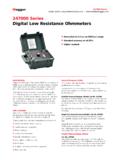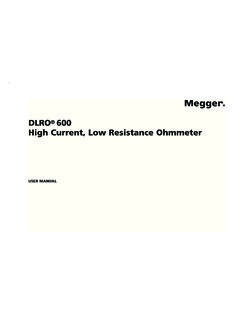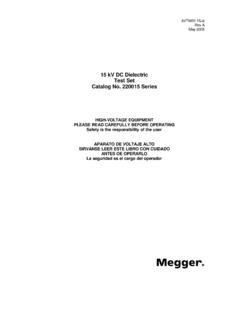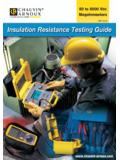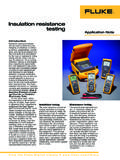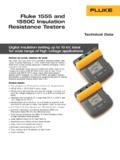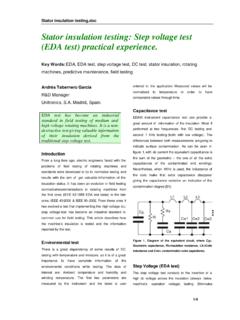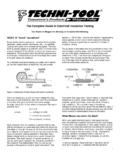Transcription of Table of Contents - BiddleMegger.com
1 MEGGER insulation Testers1 NOTEST able of 2 WHAT IS insulation ? .. 3 What Causes insulation to Degrade? .. 3 Electrical Stress .. 3 Mechanical Stress .. 3 Chemical Attack .. 3 Thermal Stress .. 4 Environmental Contamination .. 4 How Can Predictive Maintenance Help Me? .. 4 The Benefit of New Technology .. 5 HOW insulation RESISTANCE IS 6 How an insulation Resistance Tester Operates .. 6 Components of Test Current .. 6 Capacitive Charging Current .. 6 Absorption or Polarization Current .. 6 Surface Leakage Current .. 7 Conduction Current ..7 Connecting your insulation Tester .. 8 Selected Typical Connections .. 9 Shielded Power Cable .. 9 Circuit Breaker/Bushings.
2 9 Power Transformer .. 10AC Generator .. 10 insulation Resistance Tester Scale .. 11 Voltage Characteristics .. 12 EVALUATION AND INTERPRETATION OF 13 Interpretation of the Infinity ( ) Reading .. 13 DIAGNOSTIC HIGH VOLTAGE insulation 15 Spot Reading Test .. 15 Time vs. Resistance Test ..17 Polarization Index Test .. 18 Step Voltage Test .. 20 Dielectric Discharge Test ..21 Different Problems/Different Tests .. 24 Potential Sources of Error/Ensuring Quality Test Results .. 24 Test Leads .. 24 Making Measurements above 100 G ..24 Accuracy Statements .. 24 Delivery of Stated Voltage .. 24 Interference Rejection .. 25 Rules on testing and Comparing.
3 25 The Guard Terminal .. 26 Effects of Temperature ..28 Effects of Humidity .. 31 Ingress Protection .. 31 High Potential testing .. 33 Current (nA) Readings vs. Resistance (M ) Readings .. 33 Burn Capability .. 34 Drying out Electrical Equipment .. 34 Test Item Discharge .. 36 Charging Time for Large Equipment .. 36 Motor Driven insulation Testers .. 375-kV insulation Testers Available from AVO International .. 38 Distributor: MeterCenterUnited States: Edition: June 2002 2002 AVO InternationalDEDICATIOND edicated to the late Ted Balaska, who pro-vided significant help instructuring this was an expert in thefield of insulation and insu-lation testing and, moreimportant, a good O.
4 JonesJeffrey R. JowettS. Graeme ThomsonDavid S. Danner2A Guide to Diagnostic insulation testing Above 1 kVNOTESINTRODUCTIONE lectrical insulation degrades over a period of time because of various stresses,which are imposed upon it during its normal working life. The insulation has beendesigned to withstand these stresses for a period of years, which would be re-garded as the working life of that insulation . This often runs into stresses can bring about an increase in this natural aging process thatcan severely shorten the working life of the insulation . For this reason it is goodpractice to perform regular testing to identify whether increased aging is takingplace and, if possible, to identify whether the effects may be reversible or purpose of diagnostic insulation testing is: To identify increased aging.
5 To identify the cause of this aging. To identify, if possible, the most appropriate actions to correct the its simplest form diagnostic testing takes the form of a Spot Test. Most electri-cal maintenance professionals have made spot tests where a voltage is applied tothe insulation and a resistance is measured. The diagnosis in this case is limited to the insulation is good or the insulation is bad. But having made this diagnosiswhat do we do about it? It s a bit like going to the doctor with a bad cough and thedoctor simply telling you, You ve got a bad cough. You wouldn t be happy tocome away with only that information.
6 You expect the doctor to examine you,carry out a few tests, and tell you why you have a bad cough and what to do aboutit to cure the insulation testing , a spot test on its own is the equivalent of the doctor tellingyou that you are well or you are sick. It s minimal information. This is the sort oftest that is typically applied to low-voltage circuits where the cost of a failure islow and equipment can be replaced easily and inexpensively. Since the equipmentbeing tested is low voltage equipment, these tests are typically performed using a500 or 1000 V test voltage and will be familiar to all electrical maintenance , if the doctor records the results of his examination and compares themwith those from previous visits, then a trend might be apparent which could leadto medication being prescribed.
7 Similarly, if insulation resistance readings are re-corded and compared with previously obtained readings, it may be possible tosee a trend and to prescribe remedial actions if such are called insulation testing at voltages above 1 kV is an area that is less familiarto many electrical maintenance personnel. The purpose of this booklet, therefore,is to: Acquaint the reader with making diagnostic insulation resistance tests. Provide guidelines for evaluating the results of these diagnostic insulation re-sistance tests. Introduce the benefits of multi-voltage testing at higher series of appendices are included at the end of the booklet to provide the readerwith additional information related to diagnostic insulation insulation Testers3 NOTESThis booklet is based on the principles established in the booklet A Stitch The Complete Guide to Electrical insulation testing first published in 1966by the James G.
8 Biddle IS insulation ?Every electric wire in a facility, whether it s in a motor, generator, cable, switch,transformer, or whatever is covered with some form of electrical insulation . Whilethe wire itself is a good conductor (usually made of copper or aluminum) of theelectric current that powers electrical equipment, the insulation must resist cur-rent and keep the current in its path along the conductor. Understanding Ohm sLaw, which is expressed in the following equation, is the key to understandinginsulation testing :E = I x Rwhere,E = voltage in voltsI = current in amperesR = resistance in ohmsFor a given resistance, the higher the voltage, the greater the current.
9 Alterna-tively, the lower the resistance of the wire, the more current that flows for thesame insulation is perfect (has infinite resistance), so some current does flow alongthe insulation or through it to ground. Such a current may be insignificantly smallfor most practical purposes but it is the basis of insulation testing what is good insulation ? Good means a relatively high resistance to currentflow. When used to describe an insulation material, good also means the abilityto maintain a high resistance. Measuring resistance can tell you how good theinsulation Causes insulation to Degrade?There are five basic causes for insulation degradation.
10 They interact with eachother and cause a gradual spiral of decline in insulation StressInsulation is designed for a particular application. Overvoltages and undervoltagescause abnormal stresses within the insulation , which can lead to cracking or delami-nation of the StressMechanical damage such as hitting a cable while digging a trench is fairly obviousbut mechanical stresses also may occur from running a machine out of balance orfrequent stops and starts. The resulting vibration from machine operation maycause defects within the AttackWhile you would expect insulation to be affected by corrosive vapors, dirt and oilcan also operate to reduce the effectiveness of Guide to Diagnostic insulation testing Above 1 kVNOTEST hermal StressRunning a piece of machinery in excessively hot or cold conditions will causeover expansion or contraction of the insulation which might result in cracks andfailures.



